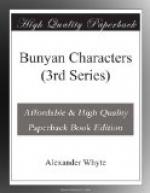Who with abundance of good things
Doth satisfy thy
mouth;
So that, ev’n as the eagle’s
age,
Renewed is thy
youth.’
The 103rd Psalm was never made in this world. Musicians far other than those native to Mansoul made for us our Lord’s-Table Psalm.
5. And then, the riddles that were made upon the King Himself, and upon Emmanuel His Son, and upon Emmanuel’s wars and all His other doings with Mansoul. And when Emmanuel would expound some of those riddles Himself, oh! how they were lightened! They saw what they never saw! They could not have thought that such rarities could have been couched in so few and such ordinary words. Yea, they did gather that the things themselves were a kind of portraiture, and that, too, of Emmanuel Himself. This, they would say, this is the Lamb! this is the Sacrifice! this is the Rock! this is the Door! and this is the Way! with a great many other things. At Gaius’s supper-table they sat up over their riddles and nuts and sweetmeats till the sun was in the sky. And it would be midnight and morning if I were to show you the answers to the half of the riddles. Take one, for an example, and let it be one of the best for the communion-day. ‘In one rare quality of the orator,’ says Hugh Miller, writing about his adored minister, Alexander Stewart of Cromarty, ’Mr. Stewart stood alone. Pope refers in his satires to a strange power of creating love and admiration by just “touching the brink of all we hate.” Now, into this perilous, but singularly elective department, Mr. Stewart could enter with safety and at will. We heard him, scarce a twelvemonth since, deliver a discourse of singular power on the sin-offering as minutely described by the divine penman in Leviticus. He described the slaughtered animal—foul with dust and blood, its throat gashed across, its entrails laid open and steaming in its impurity to the sun—a vile and horrid thing, which no one could look on without disgust, nor touch without defilement. The picture appeared too vivid; its introduction too little in accordance with a just taste. But this pulpit-master knew what he was all the time doing. “And that,” he said, as he pointed to the terrible picture, “that is SIN!” By one stroke the intended effect was produced, and the rising disgust and horror transferred from the revolting, material image to the great moral evil.’ And, in like manner, This is the LAMB! we all said over the mystical riddle of the bread and the wine this morning. This is the SACRIFICE! This is the DOOR! This is EMMANUEL, GOD WITH US, and made sin for us!




